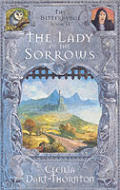
| Series: | The Bitterbynde #2 |
| Publisher: | Tor |
| Copyright: | 2002 |
| Printing: | 2003 |
| ISBN: | 0-330-48956-9 |
| Format: | Mass market |
| Pages: | 625 |
This is the second book in the Bitterbynde series. It goes off in new directions from The Ill-Made Mute, but you do miss out on character background and some linkage at the start of the story by skipping the first book.
There is a plot twist near the middle of The Ill-Made Mute which is significant for the rest of the series and which is almost impossible to not spoil. If you prefer to avoid spoilers for the first book, you should probably not read this review.
The Lady of the Sorrows shifts from lavish descriptions of the countryside to lavish descriptions of court. Dart-Thornton reins in some of her enthusiasm for parallel structure, but just as in the first book she's prone to toss out paragraphs of description at every opportunity. Previously, they were mostly of farms, woods, and odd creatures; in this book, they seemed mostly about clothes. (Well, at least for the first half. Then we got woods, island shores, and odd creatures again.) Drowning the reader in detail does do some work in the story. Amidst the endless description, one develops an almost subconscious feel for Rohain's emotional reaction to her surroundings. But it still feels padded.
That aside (or skimmed past, which was my most frequent tactic), The Lady of the Sorrows feels more dynamic than The Ill-Made Mute and surprised me several times with its plot. Refereshingly, particularly compared to the first book, Rohain's motivating reason for coming to court is resolved quickly and reasonably. For all the balls and palace social life, there's a surprising amount of plot in the first chunk of the book, and it all moved along more satisfactorily than I had expected. The annoying romance lingers from the first book and remains annoying at the start, but once Dart-Thornton gets to her destination with it, I found I didn't mind it. It's cliched, but it somehow works for the characters (thanks in part to some satisfactory description of the target of Rohain's affection through the lens of her love, once she finally gets down to thinking rather than pining).
Then, rather abruptly and just as the plot is heating up, Rohain is shuffled off to an island for safe-keeping, most of the characters of the story disappear, and we're introduced to a whole pile of new characters and detailed descriptions of life on this island. None of whom matter, and none of which appears even vaguely relevant to the plot.
I'm still baffled by this. This bizarre interlude derails dramatic tension, lost much of my interest in what was going on, and appears to primarily be a chance to tell a bunch of stories in a setting that Dart-Thornton finds interesting and didn't otherwise have access to. Story-telling has been a common theme: most of the characters tell stories at the drop of a hat, and Dart-Thornton loves embedding versions of various traditional tales, mythology, and fairy tales into these books, sometimes with only the most marginal of excuses. But this set of stories is the most egregious example of this to date. It doesn't help that the bizarre interlude comes to an end with an intensely frustrating slow-motion train wreck that makes you want to smack everyone involved upside the head. It's bad enough that I almost stopped reading.
The rest of the story does make up for this, somewhat. We finally learn Rohain's past, and apart from the fact that a large part of it is lifted directly from a traditional legend (complete with an extensive and painfully faithful retelling), it's mostly worth the build-up. Various quirks about Rohain are satisfactorily explained, her story is woven into the ongoing story of the seelie and unseelie creatures plaguing the countryside in a mildly unexpected way, and it sets up plenty of suspense and conflict for the final book. By the end, it becomes clear that Dart-Thornton is trying to tell a fairy tale writ large: a net of plot that can draw together a huge variety of common fairy themes, rules, and requirements into a variety of puzzles and situations that capture the peril and trickiness of fairy dealings.
The book this reminded me of the most is Sheri Tepper's Beauty, which uses a similar amalgam of familiar stories and standard scenarios to put together a larger story. The difference is that Tepper's use is subversive, feminist, critical, and revisionist, whereas Dart-Thornton clearly loves the traditional stories and is trying to honor and enhance them as she incorporates them. At times, she achieves an enjoyable sense of atmosphere. Mostly, though, there are an awful lot of words, an awful lot of description, and some truly odd sidetracks. If you want epic fantasy thoroughly steeped in fairy tale, this series is worth a look, but I think it would be better if it were quite a bit tighter.
Followed by The Battle of Evernight.
Reviewed: 2008-01-29